10 min read
Can the IRS Find Out About My Second Rental Income?
If you’re a new real estate investor, you might ask yourself, “Can the IRS find out about my rental income?” The answer...
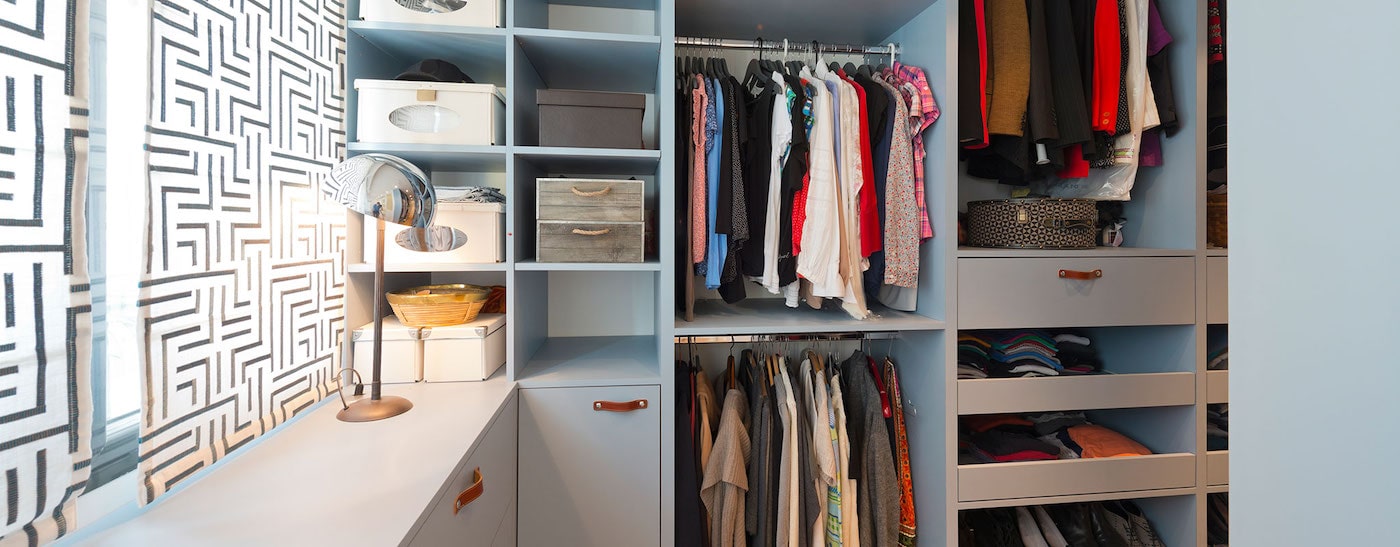
Did you know that the average apartment size in the U.S. is just 882 square feet, about the size of five parking spaces put together? While living in a small home certainly has its benefits, organizing small spaces can be a bit of a challenge and make it hard to feel at home. In order to help you make the most of your tiny home, here are 15 tips for organizing small spaces inspired by the principles of the Lagom lifestyle. Landlords should also take note of these tips, as accommodating units with these structural changes can help attract the right tenants.
Before we dive into the small space organizing hacks, let’s take a moment to understand exactly what Lagom is and how we can apply it to our homes.
Lagom, pronounced “Lah-gum,” is a Swedish word that translates to “just enough” or “just the right amount.” In Sweden, it’s often used to describe a certain type of lifestyle that focuses on balance and slow living. Though Lagom can incorporate elements of minimalism, it doesn’t require “abstinence” in the same way, rather an intentional and appropriate amount of belongings.
These days, it feels like there is a new, unpronounceable trend making its way from Scandinavia every season. However, these principles are not all the same, nor are they even from the same country. Here is a quick breakdown so you can understand where Lagom fits in:
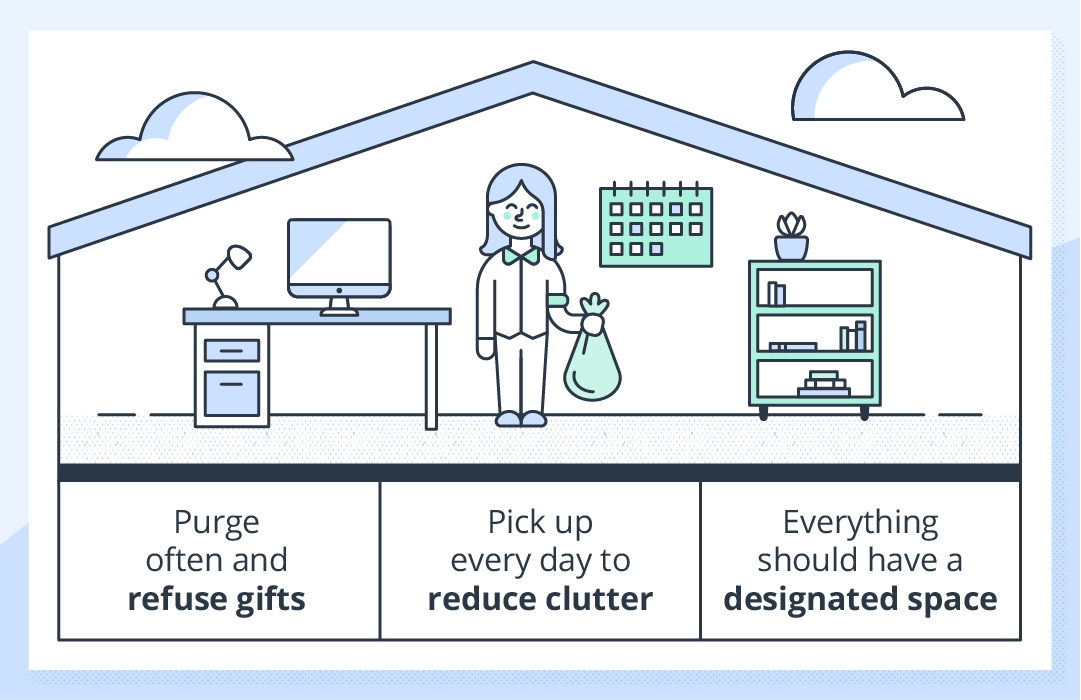
The first and primary principle of Lagom to keep in mind when organizing small spaces is the Goldilocks rule: not too much, not too little, but just right for you. Since you are dealing with a small space you’re going to have to minimize your belongings, but that doesn’t mean you have to limit yourself to function only.
Wendy Gonzalez, an interior designer, adds “when I start to plan for organization in a small home, I want to make sure that I’m not sacrificing style for the sake of convenience or space, or forfeiting space and convenience for the sake of style, there needs to be a balance between it all.” Below are some general tips that encompass this first rule of balance.
Every object in your home, from your car keys to your throw blanket, should have its proper place. Not only does this help you find things when you need them, but it helps to limit clutter that can build up on surfaces and floors. If you’re constantly finding a certain object taking up space on your tables or counter, find it a permanent home in one of your storage areas. If you can’t, that’s probably a good sign you should get rid of it.
Oliver Schultz, a representative of MI-BOX, suggests planning on paper before organizing to make everything easier. “To get more space in any room I like to start by figuring out how much space I have in square footage vs how many things I have in the space. Then I make a few drawings of the room to see where I could put specific pieces to create more space,” he commented.
We’re not saying you have to go full KonMari, but you’d be surprised how quickly your belongings can add up in a small space. Every month, you should go through your home and evaluate each room and the objects it contains. When is the last time you used your espresso maker or wore that chunky orange sweater? If you haven’t touched it since the last time you did your sweep, it’s time for it to go.
Organization expert Marty Basher recommends a similar method using a “toss” bin. “…Junk drawers can be tools for actually getting rid of unneeded items. Place a plastic tote in a closet for the exact same purpose as a junk drawer. Once a month, go through the bin and try to find uses for the items. Anything left in there for three months or more should be donated,” he says. It’s also important to refuse gifts or hand-me-downs from others if you’re not positive you’ll use what they’re offering. Sure, a giant exercise ball sounds fun, but when are you actually going to sit on that? Where is it going to be stored? These are important questions to ask yourself to avoid clutter.
In order to avoid becoming overwhelmed, it’s important to pick up after yourself every single day. Don’t leave the junk mail on the table, it’s unsightly and takes up limited surface space. Don’t throw your coat on the couch, as you’ll likely need to sit there later. As we mentioned earlier, each item should have its own designated space and you should work on making sure it stays there. Professional organizer Laura Kinsella adds, “When items have an intentional home, we automatically set limits to an area, which also maintains a streamlined look.”
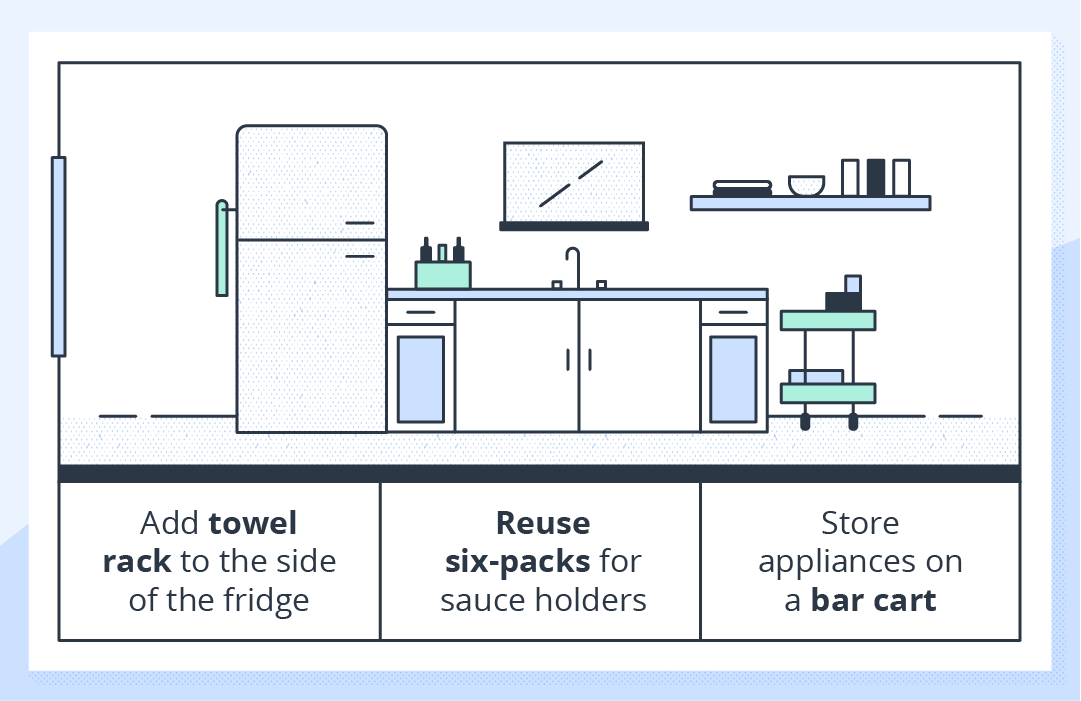
Another important principle of Lagom is to live smart by reducing and repurposing materials and space. This can be applied to small space organizing in a number of ways.
One of the most common complaints of living in a small home is the lack of outlets. This is doubly-annoying in the kitchen, as most people need at least a microwave, toaster, coffee maker, and slow cooker for day-to-day use. An easy way to get around the lack of outlets and counter space is to keep your appliances on a rolling bar cart. Instead of constantly moving the heavy appliances around or setting up a dangerous daisy chain of extension cords, repurpose this type of furniture for something more suited to your needs.
The organizers at The Cleaning Authority add that this method can be useful for other areas of the house as well. “A bin on wheels is the perfect way to keep your items out of sight when they’re not in use. You can place clothes, desk supplies, or even hair styling tools into these bins and roll them under other furniture until they are needed.”
In a small apartment, any space is good space, and the side of the fridge is a space we usually don’t consider. Repurpose this space by installing a towel rack and small shelves. Since the fridge is usually within easy reach of the stove, you can make your cooking more efficient by keeping commonly used spices or utensils on the rack as well.
Interior designer Michael Helwig suggests doing this with larger utensils too. “Ladles, slotted spoons, spatulas, etc. take up a lot of drawer space. Hang them on command hooks inside cabinet doors so they’re easy to grab and not loose in the drawer,” he says.
Most small homes also have small fridges, which means you’ll probably be cramming all of your sauces and condiments into the fridge door to make room for other food on the shelves. This can be troublesome if the sauces constantly fall over and out of the fridge when you swing open the door. Remedy this by reusing beverage six-pack containers to store the sauces more securely so you don’t end up with hot sauce all over your floor. This can also be a cute way to display and carry spices to the dinner table!
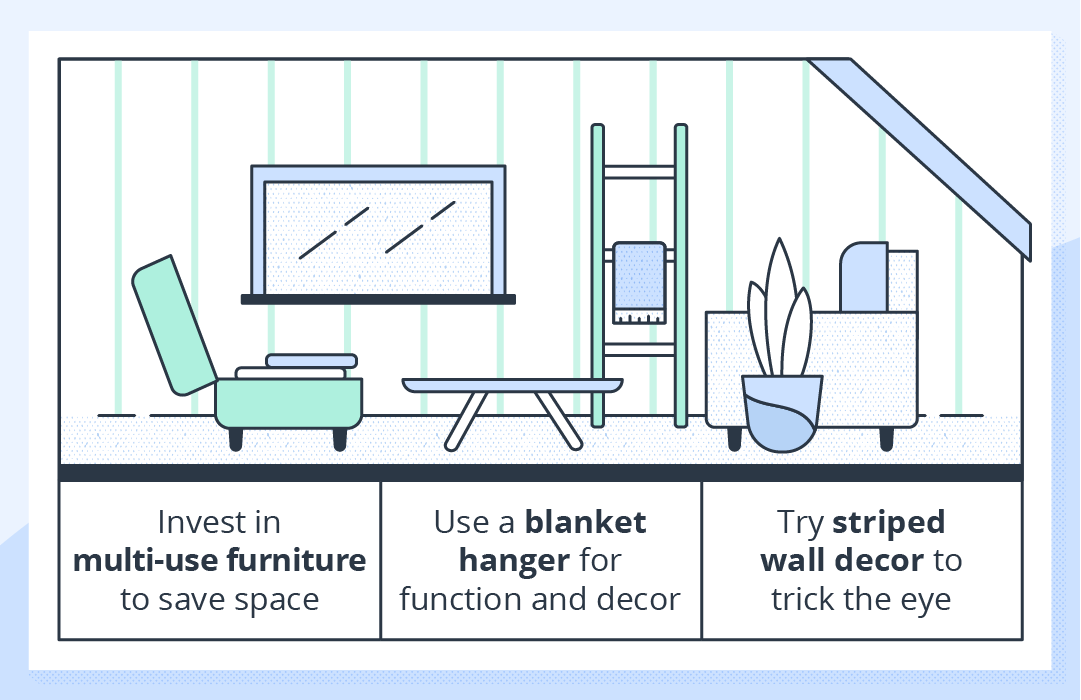
Part of Lagom is living slowly and consciously, and making sure you have just what you need, and no more than what is necessary. This is especially true when living in cramped quarters, and you’ll often need your furniture and decorations to perform double duty. Here are some ways to make sure you are getting just what you need, from less.
Sometimes, getting more from less will require a bit of imagination and creativity. If your living room feels oppressively small, you can take advantage of a neat optical illusion to make it seem more spacious. Employing vertical stripes will make the room appear taller, while horizontal stripes can make it seem wider. This can be done with wallpaper or paint, or you can try hanging certain types of wall decor to get a similar effect.
Your throw blankets can perform double duty by serving as cute and cozy living room decor as well. Purchase or build a blanket hanger as a way to both display and store your living room blankets. This is a great way to get more from less by minimizing space and multiplying function. Plus, it’s a good excuse to go out and get some cute throws. Just make sure you purge the old ones!
To make your life easier, there is plenty of furniture out there designed with this double-use principle in mind. Sherri Monte, a professional home organizer, commented that “the size of your house really doesn’t matter if you’re maximizing storage with functional furniture. A great way to think about storage in the living room could be a closed media cabinet where you can store games or crafts, or a storage ottoman that functions as a footstool or seat but also extra space for toys.” Though this furniture can be a bit more expensive than your basic living room decor, part of living smart is knowing when to invest in a few quality pieces over a multitude of less useful items.
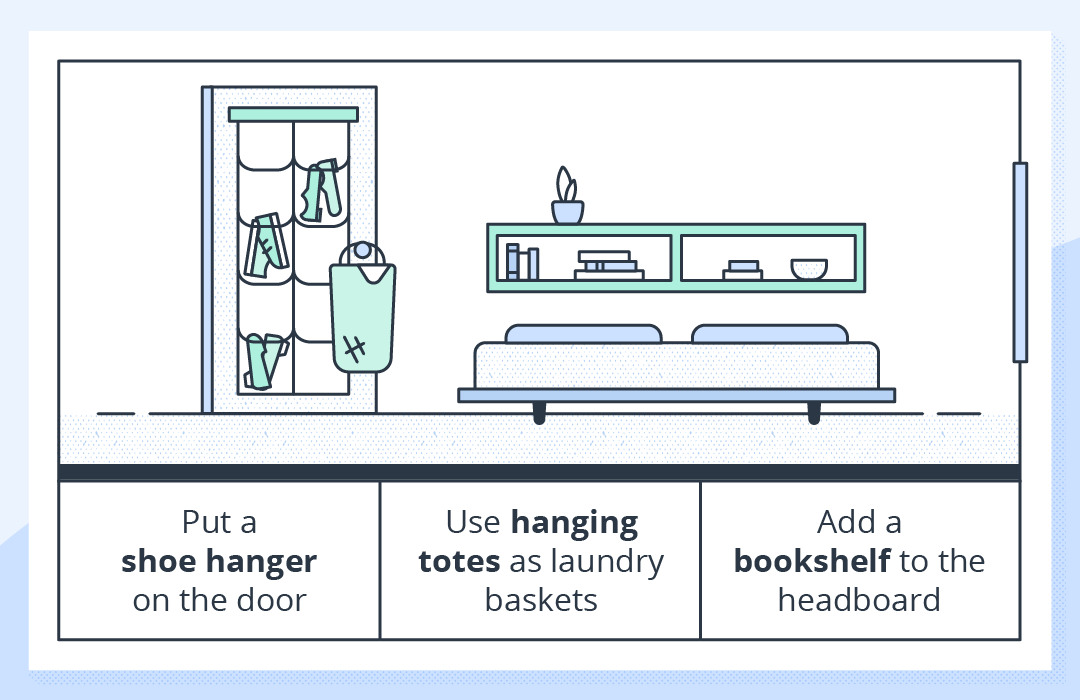
Though striking a balance between items you need and items you want sounds like an easy enough Lagom principle, it can be easy to veer off course and start stacking up unneeded belongings. Two of the biggest culprits: clothes and books. Here are a few simple ways to make sure you are keeping only what you really want.
Instead of bulky laundry baskets that take up floor space, use a couple of large tote bags for your dirty clothes. You can hang these on the outside of your closet doors to ensure they are out of the way, and they also have the added benefit of looking much cuter than your typical laundry hamper. Most importantly, smaller laundry containers help to limit the number of clothes you own as well as force you to do laundry more frequently. No longer can you hide seldom-worn clothes at the bottom of your laundry basket!
Shoes are one of the trickiest items to store because you need to use them so frequently. Shoe shelves can take up a lot of valuable floor space and piling them by the front door is not a good look. Instead, invest in a shoe hanger that you can put up on the back of your bedroom door. This will also make it easier for you to choose outfits in the morning that match certain pairs of shoes.
Organizing coach Lisa Dooley says, “These bags retail for about $20 and are a great option in almost any room in the house. I recommend clear bags vs opaque so you can see the contents clearly. You can also use them to organize jewelry, tights and underwear, scarves, toiletries, just about anything.” Similar to the first tip, it also allows you to monitor the exact number of shoes you own so you don’t go overboard. Don’t have any more empty shoe pockets on the hanger? You know that you shouldn’t buy any more, or that you should get rid of some shoes you don’t wear.
Installing a bookshelf above your headboard is an easy way to add a homey touch to your bedroom, as well as ensure your book collection is kept off the floor. You can either have the shelf sitting on top of your headboard or mounted on the wall behind it depending on the type of bed frame you have.
Professional organizer Lauren Williams says “If you are able to alter your spaces, floating shelves in any room can add display or practical storage space. Even the space above a door can be converted to extra storage.” Once again, having this finite space available for a specific object (in this case books) allows you to keep a handle on the number of items you own. Once the space is filled up, it’s time to get rid of some books if you want to get new ones!
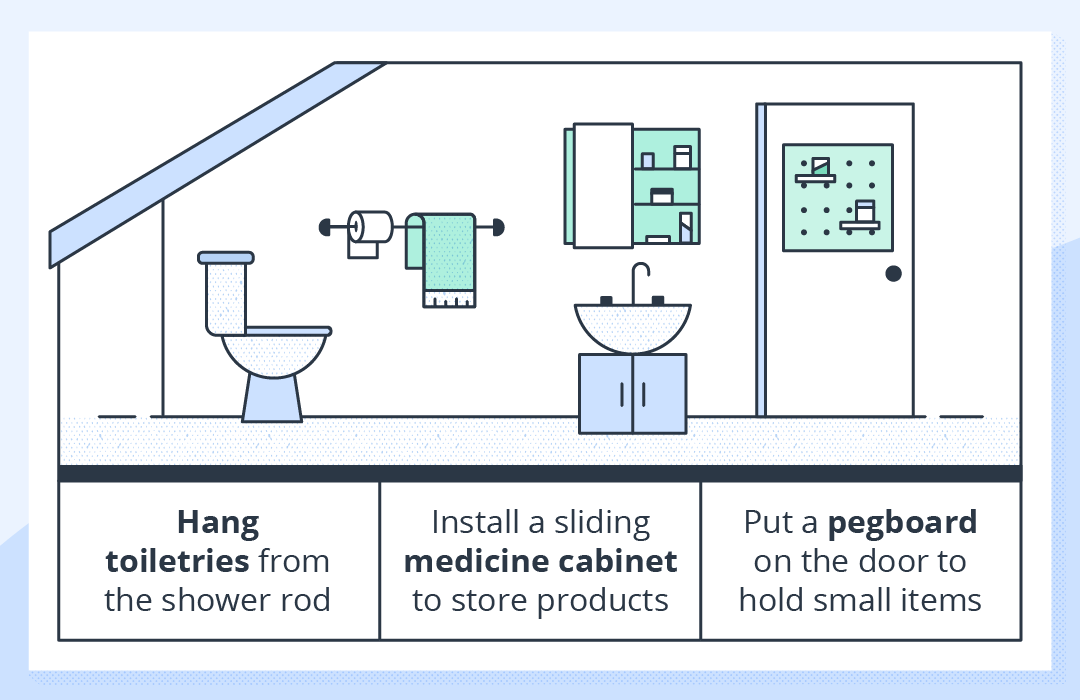
The last principle of Lagom we want to cover incorporates all previous points, and states that nearly all of the items in your small home should have a purpose and be used to their full potential. Sometimes, this requires a little imagination! Here are some organizing examples you can try in your bathroom.
Just like we talked about with the side of the fridge, no space should go overlooked in a small apartment. Install a pegboard on the back of the bathroom door, and add hooks and small shelves for storage. You’ll be able to hang towels and shower caddies, as well as have frequently-used items in easy reach such as your toothbrush and toothpaste. This can be an especially important addition if your bathroom lacks counter space.
Is a mirror just a mirror? No, it can be extra storage, as can anything with a little creativity! Lack of bathroom drawers can be irritating and is unfortunately common in many small apartments. To get around this, you can put up a medicine cabinet in place of, or in addition to, the typical wall mirror. Make sure it has a sliding door instead of one that swings outward since space can be so limited in a tiny bathroom.
This tip is a little unorthodox but can do the trick if you’re stuck with a small standing shower and no bathtub ledges to hold shampoo and conditioner. The curtain rod can hold more than just the shower curtain, so make full use of its potential by adding metal clips between the rings where you can hang your bath products and save space on the shower floor.
We hope these Lagom-inspired tips will help you enjoy your small home to its full potential, and learn how to lead a more balanced, intentional lifestyle. Download the full guide to organizing small spaces with Lagom above, and visit TurboTenant for more apartment living tips and tricks.
10 min read
If you’re a new real estate investor, you might ask yourself, “Can the IRS find out about my rental income?” The answer...
14 min read
Managing a tenant not paying rent is a frustrating and challenging experience for landlords. It’s especially true if you rely on the...
15 min read
Learning how to calculate a rental property’s cap rate helps you evaluate its potential income, weigh it against other investment opportunities, and make more...
Join the 700,000+ independent landlords who rely on TurboTenant to create welcoming rental experiences.
No tricks or trials to worry about. So what’s the harm? Try it today!
TurboTenant, Inc., © 2025
Created in Sunny Colorado